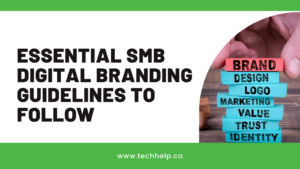Even though we often use digital branding and digital marketing interchangeably, these two terms are not synonymous.
Digital marketing focuses on conversions, while online branding is all about delivering valuable customer experiences.
Digital branding makes your brand memorable and recognizable by your target audiences. But, most importantly, it increases brand credibility and inspires loyalty.
What are the elements of a digital brand? How do you start branding your SMB online? Here are a few steps to take.
Research Your Target Audience & Create Buyer Personas
Understanding the target audience is the basis of your digital branding strategy.
Start by collecting customer data and mapping their buying journeys. Here are some things you can do:
- Measure website performance: Use Google Analytics or other equivalent software to track website metrics like the average session duration, page views, goal completion, sessions by channel, etc. These metrics help identify which content types and marketing tactics resonate with your audiences. That way, you may gain better insights into their needs and preferences.
- Conduct online surveys: You can use numerous survey creation tools to create custom surveys for your audiences. Make sure survey questions are clear, simple, and easy to answer. Once you develop a survey, choose your preferred distribution channel, such as your email list or social networks.
- Analyze your current customer base: You have nothing to worry about if you use a customer relationship management (CRM) tool. The tool captures customer information from various online channels and keeps it central. That way, you can stay on top of customers’ historical data and use it to understand their expectations.
Based on the information you collect, create buyer personas.
These are semi-fictional characters that represent your ideal customer base. While you cannot get to know each customer, you can understand your target audience’s key needs, requirements, and pain points.
Build your customer personas on deep research. For starters, analyze their demographic data, such as age, gender, geolocation, job title, language, income level, etc. Next, define their psychographic data, such as their hobbies, interests, content preferences, and buying motivation.
Design a Logo
A logo is the first thing people see when interacting with your brand for the first time. It increases brand awareness, recall, and loyalty. Here is a simple example. Whenever you hear Nike, you instantly create a mental image of its swoosh sign.
Here are some tips:
- First, define your brand’s traits before designing a logo. For instance, is it modern or vintage? Quirky or serious? Brand personality impacts every aspect of logo design, from colors to messaging.
- Avoid complicated logos that are difficult to memorize and recall. Instead, make sure your logo is simple, unique, and powerful. For example, the Nike Swoosh is one of the most iconic logos of all time for a simple reason: it’s easily memorable and yet, perfectly communicates the brand’s purpose.
Remember that digital branding incorporates various platforms and devices, such as websites, social networks, email, apps, etc. Some channels require specific image sizes, so design a logo that will look good on all platforms.
Build a Seamless Website
A website is an essential element of your online presence, and most online shopping journeys start with it. Because of that, building and optimizing a user-friendly and on-brand website is paramount.
Here are a few steps to take:
- Use your brand name as a domain name to boost website visibility. That way, when a user googles your company’s name, your website will be the first thing they see in search engines.
- Pick the domain extension that aligns with your brand. For example, some companies choose the .me domain to humanize their brand. However, .com is the most common TLD (top-level domain).
- Ensure everything about your company is on the website, including brand name, colors, value proposition, etc.
- Use legible, simple, and bold fonts that do not distract users.
- Make your CTA buttons attention-grabbing by using contrasting colors.
- Use simple, user-friendly website navigation menus. For example, hamburger navigation menus work perfectly on both PCs and smartphones.
- Keep website information easily crawlable. You want users and search engines to navigate through your website effortlessly.
- Check the performance of website elements, such as links, buttons, or images.
Strengthen Your Brand Message
The primary goal of online branding is to promote your brand as a credible industry player. To do that, you need to communicate your brand values, goals, and missions consistently across all digital marketing channels.
- When building a consistent brand message, start by performing competitor analysis. The goal is to understand how your rivals communicate their message to customers. Most importantly, you will identify which tactics resonate with online audiences the best.
- Your brand message should focus on your customers’ pain points and provide solutions to each. Make it easy for your audience to understand what products you sell and their benefits.
Produce High-Quality Content
Content is the core component of any successful digital marketing strategy. Regardless of a customer’s stage in your sales funnel, quality content delivers value to them – it increases user engagement, generates leads, maximizes purchases, and inspires brand loyalty.
- For starters, keep your content original, authoritative, and reliable. Always support it with up-to-date statistics, examples, and research studies.
- Showcase your industry knowledge and experience through whitepapers, eBooks, comprehensive guides, podcasts, or case studies. That should help prove you are a credible industry name and inspire customers to do business with you.
- Always keep your content on-brand. For example, include your brand name and logo when publishing an infographic. Use brand colors and fonts to make your content easily recognizable. When creating visual content, always use the same filters. Keeping your content consistent across multiple channels will increase brand recall and memorability.
Build a Social Media Presence
According to recent statistics, there will be 4.41 billion social media users worldwide by 2025. As a small business owner, you cannot afford to ignore social media, and here’s why:
- For starters, social media networks are effective customer service channels. You can also use social media listening tools to track brand mentions and hashtags, encourage customer feedback, and quickly respond to positive (and negative) comments. All of those can help your brand image immensely.
- You can place your brand in front of wider audiences by pairing high-quality content with the strategic use of hashtags and keywords. Apart from promoting content from your blog, create unique social media content – these could be video stories, live stories, high-quality images, inspirational quotes, quizzes, UGC (user-generated content), etc. All of these things can help brand reach and awareness.
- Influencer collaborations and user-generated content through social media can help build consumer trust and increase sales.
- Selling on social channels like TikTok or Instagram can improve user experiences. By allowing customers to purchase without leaving their social app, you shorten the buying journey.
It’s essential to invest in content consistency on social networks. In other words, create a detailed content calendar and stick to it. Invest in social media management software like Hootsuite or Buffer to automate some content publishing tasks. You have to schedule the post, and the tool will automatically publish it.
Over to You
Remember that there is no uniform approach to SMB branding in the online ecosystem. Your brand-building techniques depend on your company’s industry, audiences, and budget.
That is why you should build a detailed digital branding strategy supported by actual audience and market research. Only by getting to know your audiences can you develop a digital brand that resonates with each one.
This article explained the essential elements of an online brand, such as logos, websites, brand messaging, quality content, and social media presence. However, keep in mind that these channels do not exist in a vacuum. Consistency is key to establishing a recognizable and authoritative brand in the competitive digital landscape.
About the Author
Lilly Miller is a freelance writer who focuses on the latest business trends, commercial design, and environmental issues. She shares her home with two loving dogs and a gecko named Rodney. You can find her hanging out on Twitter.
Related: Branding in Digital Marketing

This content is from a contributor and may not represent the views of Tech Help Canada. All articles are reviewed by our editorial team for clarity and accuracy.
Want a heads-up once a week whenever a new article drops?







